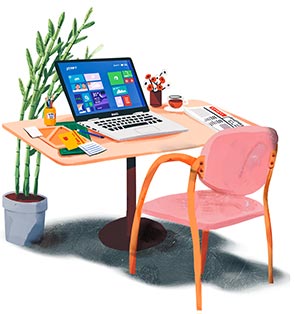If you’re in hospitality, one of the key concepts that you’ll come across is RevPAR or Revenue Per Available Room. Why does it matter? RevPAR is a crucial metric used to monitor the business performance of your hotel/serviced apartment. You should use it to track what they call pure room revenue, without any additional services such as spa, room service, laundry, food and beverages, tours, etc. In this manner, you will get an idea as to the value of each room that is available in your property. RevPAR can be calculated on a monthly, daily, or annual basis.
The usual formulas include the following-
Room Revenue/Rooms Available or Average Daily Rate (ADR) x Occupancy Rate
Let’s now dive deeper into the importance of RevPAR in the hotel sector.
Why RevPAR Matters
RevPAR is not just another KPI that you tick off while compiling your hotel revenue sheets. It’s important for these reasons:
-
You can plan your room rates smartly, deciding on the profit that you wish to gain from your rooms with the formulas. Based on the profit percentage, you can work out the forecasted RevPAR and then finalize the rates likewise.
-
You can track your business performance better with RevPAR and also strategize on hitting the sweet spot in terms of profitable room rates. If you have higher occupancy and RevPAR alike, it clearly shows that your property is performing well.
How to Increase Hotel RevPAR- Tried & Tested Strategies
Now, if you’re wondering how to increase hotel RevPAR, there are several strategies that might help. Some of them include:
-
Revenue Management Tactics
It means selling the right room to the right guest at the right price and time. Sounds simple, right? It rarely is! You’ll have to smartly adjust prices based on demand, supply, and other seasonal factors. When demand goes up, your room rates should move upwards accordingly, and vice versa. So, you’ll need a dynamic pricing manager with a booking engine/channel manager integrated platform to handle things. You’ll only have to define multiple occupancy slabs and set the rates for each of them. The software will automatically update and tweak pricing based on changes in occupancy levels.
-
Varying Pricing Strategies
You’ve already seen how the ADR matters. Now, the RevPAR is directly proportional to the ADR. Thus, the higher the latter, the higher the RevPAR as well. That doesn’t mean that you can hike room rates randomly without justification, pricing yourself out of the guests’ minds! It simply means being strategic, i.e., chalking out varying pricing strategies for low and high seasons, weekends, weekdays, etc. Create different room rates for multiple segments like leisure and business travellers, figure out the optimum rates through competitor analysis, and optimize ADR wherever possible.
-
Balance the ADR & Occupancy Percentage
RevPAR mostly depends on the occupancy and ADR. You should not look at a constant ADR and 100% occupancy. Rather, you should play with the ADR to scale up RevPAR. In many cases, higher occupancy may actually lead to lower profits, while a higher number of rental units will not offset your loss in terms of the average rate.
-
Concentrate on Direct Bookings
OTAs will undoubtedly drive more bookings throughout the year, although you should also mix it up with Google Hotel Ads, an optimized website, and personal branding/marketing to drive direct bookings (minus commissions to OTAs). The latter will help you maximize revenues/profits. You should integrate a booking engine with your site and gradually reduce your dependence on OTAs.
-
Lower your Cancellation Rate
Higher cancellation rates are a major pain point, as you’ll testify! It also impacts the RevPAR considerably, to say the least. Try to shift towards a higher percentage of non-refundable reservations without changing your cancellation policy. It will also lower the cancellation rate and boost occupancy alongside.
-
Plan your Room Rates Based on the Stay Length
A minimum length of stay mandate is still widely seen as the best way to scale up your RevPAR. You can accept long-term stays more, offering higher incentives to those making these bookings (following the minimum length of stay model). Also take reservations at discounted rates for those booking for a maximum number of nights.
-
Manage Online Reviews Carefully
Almost 50% of global travellers book hotel rooms after minutely going through reviews left by others. Hence, focus on the online reputation of your property in order to build significant brand value and attract more customers. Remember that reputation has a direct relationship with your revenue. Thus, don’t miss out on responding to customer reviews promptly.
Conclusion
Of course, other strategies that encourage repeat business, i.e. loyalty programs, discounts, exclusive perks, etc. may always work to boost occupancy and RevPAR in turn. You can build attractive packages including amenities, activities, and more, to increase overall revenues. Target your marketing campaigns to reach out to specific market segments/groups while considering extended stay policies alongside.
It’s also vital to keep enhancing ancillary revenues through spa treatments, local activities, room service, and so on. Execute cross-selling and up-selling strategies through your trained staff members, while utilizing email marketing to build a loyal customer base. Optimize your booking process, check-ins and check-outs, and property management system (PMS) to handle everything efficiently. Here’s to a higher RevPAR and smiles all around!
 aPerfect PMS
aPerfect PMS aPerfect Channel Manager
aPerfect Channel Manager aPerfect Concierge
aPerfect Concierge aPerfect Housekeeping
aPerfect Housekeeping



Divya Bansal
Published on May 28, 2025 🕒 minute read
0